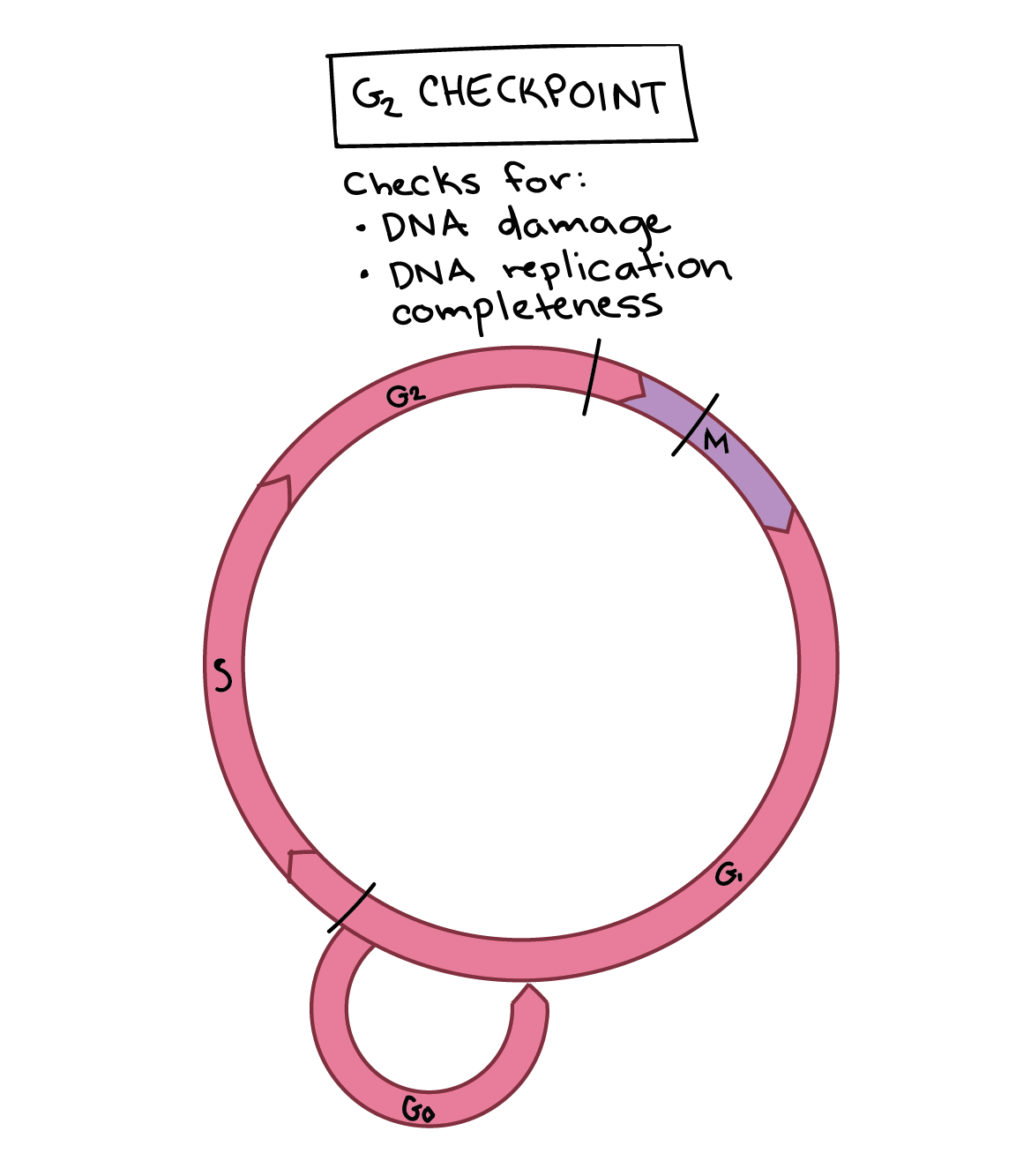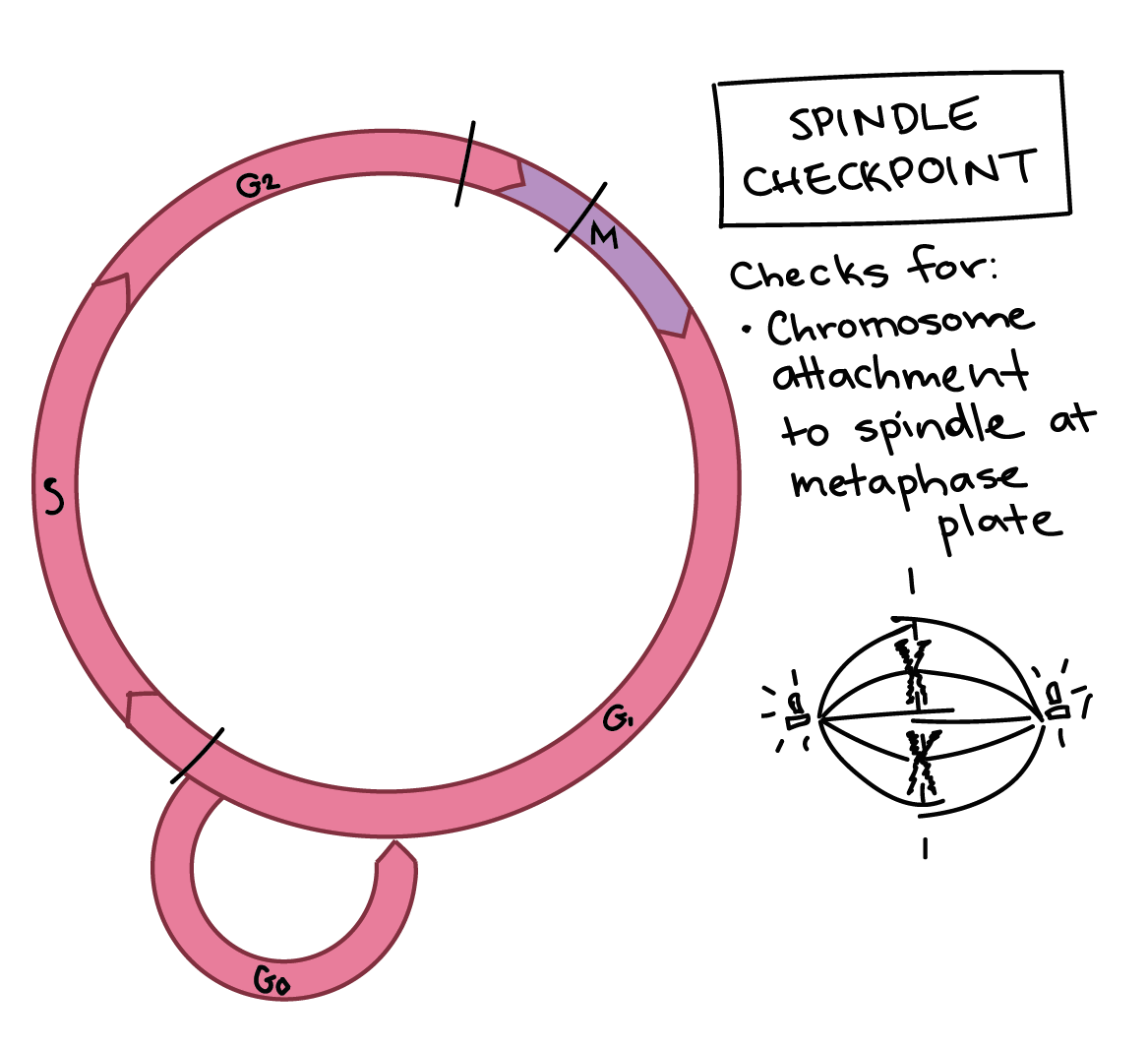Introducción
A medida que las células avanzan a través del ciclo celular, ¿van como si nada a través de una fase a la otra? Si son células cancerosas, la respuesta podría ser sí. Las células normales, sin embargo, se mueven a través del ciclo celular de una manera regulada. Utilizan información sobre su propio estado interno y señales del entorno que les rodea para decidir si se debe proceder con la división celular. Esta regulación se asegura de que las células no se dividan en condiciones desfavorables (por ejemplo, cuando su ADN está dañado o cuando no hay espacio para más células en un tejido u órgano).
Puntos de control del ciclo celular
A checkpoint is a stage in the eukaryotic cell cycle at which at which the cell examines internal and external cues and "decides" whether or not to move forward with division.
There are a number of checkpoints, but the three most important ones are:
- El punto de control G, en la transición G/S.
- El punto de control G, en la transición G/M.
- Punto de control del huso, en la transición de metafase a anafase.
El punto de control G
The G checkpoint is the main decision point for a cell – that is, the primary point at which it must choose whether or not to divide. Once the cell passes the G checkpoint and enters S phase, it becomes irreversibly committed to division. That is, barring unexpected problems, such as DNA damage or replication errors, a cell that passes the G checkpoint will continue the rest of the way through the cell cycle and produce two daughter cells.
At the G checkpoint, a cell checks whether internal and external conditions are right for division. Here are some of the factors a cell might assess:
- Tamaño ¿La célula es suficientemente grande para dividirse?
- Nutrients. Does the cell have enough energy reserves or available nutrients to divide?
- Señales moleculares ¿La célula está recibiendo señales positivas (como factores de crecimiento) de sus vecinas?
- Integridad del ADN ¿Está dañado el ADN?
These are not the only factors that can affect progression through the Gcheckpoint, and which factors are most important depend on the type of cell. For instance, some cells also need mechanical cues (such as being attached to a supportive network called the extracellular matrix) in order to divide.
If a cell doesn’t get the go-ahead cues it needs at the G checkpoint, it may leave the cell cycle and enter a resting state called G phase. Some cells stay permanently in G, while others resume dividing if conditions improve.
El punto de control G
To make sure that cell division goes smoothly (produces healthy daughter cells with complete, undamaged DNA), the cell has an additional checkpoint before M phase, called the G checkpoint. At this stage, the cell will check:
- Integridad del ADN ¿Está dañado el ADN?
- Replicación del ADN ¿El ADN fue completamente copiado durante la fase S?
If errors or damage are detected, the cell will pause at the G checkpoint to allow for repairs. If the checkpoint mechanisms detect problems with the DNA, the cell cycle is halted, and the cell attempts to either complete DNA replication or repair the damaged DNA.
If the damage is irreparable, the cell may undergo apoptosis, or programmed cell death. This self-destruction mechanism ensures that damaged DNA is not passed on to daughter cells and is important in preventing cancer.
Punto de control del huso
The M checkpoint is also known as the spindle checkpoint: here, the cell examines whether all the sister chromatids are correctly attached to the spindle microtubules. Because the separation of the sister chromatids during anaphase is an irreversible step, the cycle will not proceed until all the chromosomes are firmly attached to at least two spindle fibers from opposite poles of the cell.
How does this checkpoint work? It seems that cells don't actually scan the metaphase plate to confirm that all of the chromosomes are there. Instead, they look for "straggler" chromosomes that are in the wrong place (e.g., floating around in the cytoplasm). If a chromosome is misplaced, the cell will pause mitosis, allowing time for the spindle to capture the stray chromosome.
¿Cómo funcionan en realidad los puntos de control?
This article gives a high-level overview of cell cycle control, outlining the factors that influence a cell’s decision to pause or progress at each checkpoint. However, you may be wondering what these factors actually do to the cell, or change inside of it, to cause (or block) progression from one phase of the cell cycle to the next.
The general answer is that internal and external cues trigger signaling pathways inside the cell that activate, or inactivate, a set of core proteins that move the cell cycle forward. You can learn more about these proteins, and see examples of how they are affected by cues such as DNA damage, in the article on cell cycle regulators.
http://highered.mheducation.com/sites/0072943696/student_view0/chapter3/animation__control_of_the_cell_cycle.html (animación)




No hay comentarios:
Publicar un comentario